
|
<<Back |
Côte d'Azur, France
May 6-13,
2006 |
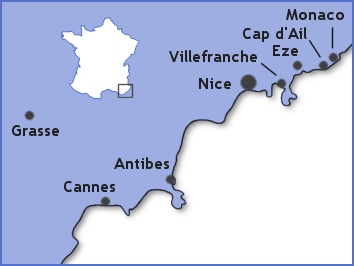
|
|
|
| Since D was on temporary assignment
in France, we arranged our last few trips (Cinque
Terre, Alsace, Geneva,
Savoie) around his base of operations. So following
suit, we booked a week on the Côte d’Azur in May
to live in the lap of luxury. Unfortunately, D was recalled
to the US several months early, so we were faced with
the dilemma of cancelling our arrangements (not without
financial penalty) or making the trip abroad. In the
end, we chose to renew our love-hate relationship with
la belle France. |
|
|
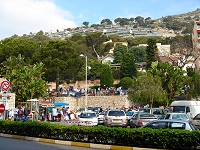
Our cliff-top hotel.
|
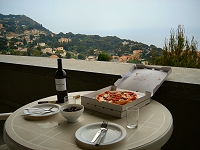
Dining al fresco on the terrace.
|
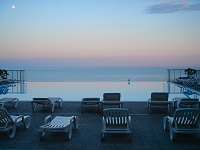
Evening at the pool.
|
|
|
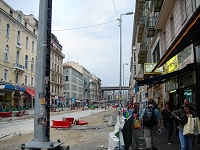
Nice - off the beaten path.
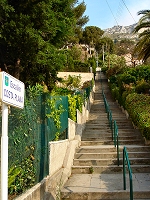
The dreaded 3rd stage of the
Escalier Costa Plana.
|
Safely on the ground at the
Nice airport, we hopped a bus for Nice proper. D was
too impatient to wait for the bus to the train station,
so we elected to grab the more frequent bus to the
downtown bus station because the posted schedule stated
that the driver would stop at the train station upon
request. Well, the driver didn’t see it that way,
and we found ourselves hoofing it to the train station
with full packs. Wanting to get to our hotel in Cap
d’Ail as soon as possible, we jumped the first train
in that direction and got off in Monaco. The underground
train station in Monte Carlo runs almost the length
of Monaco, so we were able to take advantage of the
moving walkways until we exited close to the western
limits of the principality that borders the community
of Cap d’Ail.
It is easy to forget that much
of the French Riviera is vertical. It is, after all,
where the Alps meet the Mediterranean, and the seaside
towns grow from the shore up the mountain sides. As
we strolled into Cap d’Ail looking for our hotel,
this fact could not have been clearer. Perched 300ft
up the side of the calanche was our destination
for the night. After traveling for 12 hours, taking
full advantage of the liquor available on British
Airways, and nearly walking the length of Nice and
Monaco, we had to dig down deep to climb the 271 steps
of the Escalier Costa Plana to our bed for the night.
It was a climb with which we would become very familiar
over the next few days.
|
|
|
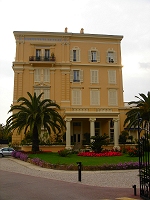
The Hotel Eden.
|
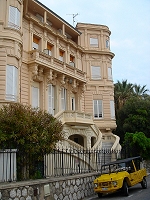
One of the Lumière villas.
|
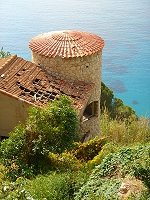
A fixer-upper.
|

Villa Helios.
|
|
|
The temperature along the Riviera
in early May can be particularly unpredictable. While
it’s never quite cold, it can hover around the high-sixties,
meaning the appearance of the sun will dictate whether
it will be jacket and long pants or shorts and a t-shirt.
Our first day was partly cloudy but the sun looked
to peek through at one point. This coupled with the
slight jetlag was the deciding factor in our choice
to hang around locally and scope out the town.
Cap d’Ail itself is unimpressive
as is its history. While the name translates to “cape
of garlic”, it is actually believed to come from Cap
d’Abaglio or “cape of the bee” which explains the
bees on the town’s crest as well as its choice to
host an annual bee festival in the summer. Thank God
we didn’t choose that week to visit. Upon the completion
of the railroad in 1880 that connected the string
of Riviera resort towns, the Baron of Pauville, a
financier of renowned reputation, tried to throw his
considerable weight around to attract the wealthy
to invest in the environs of Cap d’Ail. At the turn
of the century, the Riviera was already booming, and
Pauville built the grand Hotel Eden to capitalize.
Soon, the upper class began to come, and aristocrats
such as the writer Gabrielle Reval, the actor Sacha
Guitry, and the fathers of cinematography, the Lumière
brothers, built elaborate villas along the Cap d’Ail
coastline. The town quickly became a center for health
enthusiasts and has since played host to the likes
of the Prince of Wales, Greta Garbo, and Winston Churchill.
Today, droves of French come
for their August vacations to bronze on the beaches
and to explore the Sentier Littoral, a 3 km path that
leads past many of the Belle Époque villas
– not unlike the Cliff
Walk in Newport, RI. Cap d'Ail's oldest monument
is the 12th century Tour de Sarasine which guarded
the route eastward, making it then, as it is today,
the gateway to Monaco.
|
|
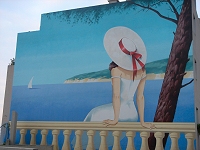
Seaside mural.
|
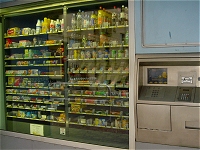
World's largest vending machine.
|
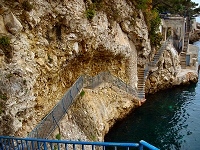
Sentier Littoral.
|
|
|
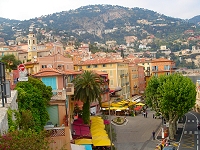
Downtown Villefranche.
|
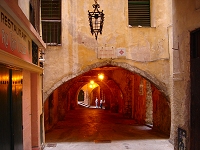
Rue Obscure.
|
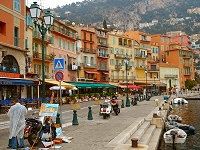
The beautiful quay at Villefranche.
|
|
|
While planning this trip, we
had wrestled between staying in Cap d’Ail for its
proximity to Monaco and in Villefranche for its beauty.
Although we opted for the former, we couldn’t resist
seeing what we had missed. So we found ourselves with
an afternoon free to stroll around Villefranche-sur-Mer.
It is as quaint a town as you can find nowadays on
the Riviera. Having all the necessary elements – a
medieval vieille ville with narrow, steep,
and winding streets, green-shuttered and ochre-façaded
cafés along the quay, and an imposing citadel
staring down at it all - the town is a true gem. The
unusually deep harbor has been a refuge for ships
since the Roman era, prompting Charles II to declare
it a villam francam.
|
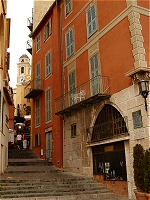
Steps abound.
|
|
|
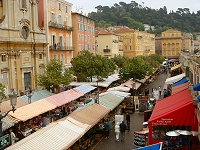
The weekend market.
|
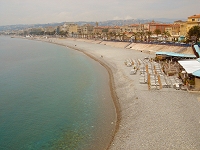
The pebbly beach at Nice.
|
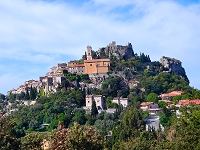
The hilltop town of Eze.
|
|
|
Getting up and down the Côte
d’Azur is pretty convenient. In addition to a highway
that is cut through the mountains some distance inland,
there are three winding roads called corniches
that hug the coastline. The Grande Corniche, following
the old Roman road and built by Napolean, is the highest
of the three and offers access to some of the more
remote villes perchées of the Maritime
Alps. The Moyenne Corniche provides spectacular birds
eye views of the capes and harbors along this part
of the Mediterranean. Lastly, winding through the
seaside resort towns themselves, is the Corniche Inférieure.
If you are sans voiture, as we were, one is
pretty much confined to the buses that use the corniches
or the train that runs parallel to the Corniche Inférieure.
The system works pretty well but is not without its
peculiarities. The bus drivers, for example, do not
wait for you to sit down (or even get near a seat)
before accelerating on their way. We witnessed more
than a few tourists unaccustomed to this practice.
In fact, J was unceremoniously groped by a woman falling
towards the back of the bus looking for something
of which to grab hold. The drivers are equally adept
at using the brakes as they are the accelerators,
so the whole ritual can happen in reverse. The sharp
turns of the corniches are also navigated at
breakneck speed, making bus travel a two-handed affair.
Trains, on the other hand, tend to be less exhausting
and faster, but they may or may not stop at your destination
depending on the time of day or day of week - and,
of course, we speak of France so there is always the
threat of a strike.
No matter what mode of transportation
you choose, you will invariably end up in Nice. It
is the capital of the Riviera, has the second largest
airport in France, and all the trains seem to go through
its gare. Likewise, the buses terminate at
the gare routière in Nice. Unfortunately,
the train and bus stations are not within reasonable
walking distance, so you must rely on the Nice city
bus system. So this is where we found ourselves on
our way to Cannes. After an hour and a half on a bus,
we were now waiting for another bus to take us to
the train station from which we were hoping to get
to Cannes. When the 12:30 bus didn’t even show, we
decided to bag the idea of visiting Cannes and spend
the afternoon in Nice instead. D lived in France for
a year and has since learned that planning is a futile
exercise. Unpredictability, be it transportation,
business hours, or the availability of menu items,
is woven into the fabric of French life. The only
things that run like clockwork are mealtimes.
If you only have a week to
spend on the Riviera, skip Nice or at least keep your
time there to a minimum. Once you get past a stroll
along the Promenade des Anglais, there’s not much
more to offer. It is too large, too congested, and
has too little to see to make it worth the time. We
strolled along the beaches and had lunch in the vieux
port before heading back home.
|
|
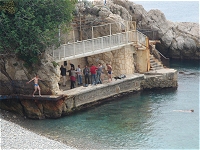
A swimming area for police only.
|
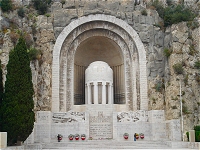
Nice war memorial.
|

The ferry to Corsica.
|
|
|
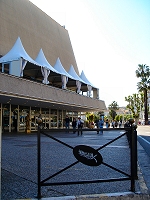
Palais des Festivals.
|
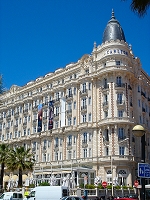
The Carlton Hotel.
|
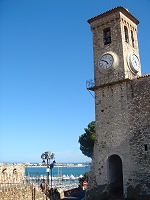
Notre-Dame-de-l'Espérence
|
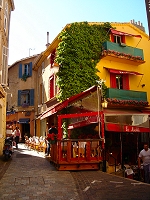
La Suquet
|
|
|

The beach along La Croisette.

Sand sculpture.
|
We did in fact eventually make
it to Cannes. The town was already buzzing with preparations
for the upcoming film festival. Giant movie posters
were being hung from the luxury hotels, barricades
to herd the crowds were being dropped into place around
the Palais des Festivals, and camera-laden paparazzi
were already roaming the private hotel beaches hoping
for a payoff picture of a topless or pregnant starlet.
We dined at the Miramar, one of the many restaurants
on the beach, and walked the length of La Croisette
to admire the palatial hotels. We couldn’t resist
stopping in the Carlton’s lounge to have an outrageously
expensive drink. In our shorts and sandals, we were
clearly out of our element and were treated as such
by our waiter.
At the end of La Croisette is the
vieux port and La Suquet, the old city built on a
hill with medieval narrow streets and topped with an 11th
century castle. From the summit, one can see the Îsle
des Lérins that host a monastery as well as a fort
in which the Man in the Iron Mask was reputed to have been
held.
|
|
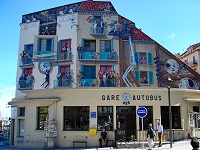
An homage to Cannes' film heritage.
|
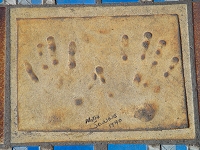
Scorcese's imprint.
|
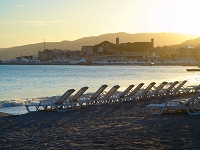
Sunset on the beach.
|
|
|
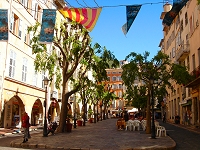
Place aux Aires.
|
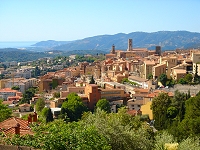
Not far from the coast.
|
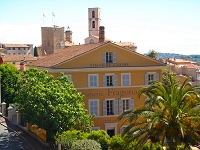
The Fragonard perfume factory.
|
|
|
During J’s Christmas visit
to Provence
several years ago, D had ambitious plans of visiting
the perfume capital of Grasse, but in the end, time
was tight, and things fell through. So when the idea
of going to the French Riviera came up, forgoing a
trip to Grasse was never considered. Long before its
olfactory fame, Grasse was identified with tanneries
in which hides were turned into leather goods of all
kinds but especially gloves. Leather gloves were particularly
fashionable in pre-revolution Paris, but they had
one serious drawback. The low air permeability of
leather coupled with an aversion to bathing of the
time meant that wearing the gloves could be malodorous.
Situated in the south of France, Grasse leveraged
its ingenuity and floral natural resources to produce
perfumed gloves. After the revolution, the gloves
faded away but the perfume thankfully remained. For
years, Grasse has been home to the perfume factories
of Galimard, Molinard, and Fragonard, but with the
emergence of the large perfume houses of Paris, the
factories now act merely as suppliers of fragrances
to be used in some of the world’s most recognizable
perfumes.
After a visit to the Molinard
factory, D treated J to a session to create her own
scent. Under the guidance of the resident nez,
J was coached on creating a personalized perfume.
As with most seemingly simple things, there’s more
to it than meets the eye – or nose as the case may
be. Perfumes are a cocktail of essences and oils that
fall into seven families: citrus, floral, ambers/orientals,
fougère (literally “fern”), leather,
woody, and cyprus (named for the country where many
of the sources are found). When constructing the desired
formula, one must consider the three “notes” that
dictate the strength of the scent. Fragrances forming
the note de tête or “top note” of the
perfume will provide the first impression with an
odor that lasts several seconds. Sharp aromas like
those from the citrus family are typical examples
of this note. The note de coeur or “heart note”
constitutes the body of the perfume and has a scent
that endures up to an hour after application. Most
feminine perfumes have floral essences for this note,
and are used to offset the more pungent note de
fond (base note) which is used to boost the other
notes and is only detectable after half an hour. Common
base notes include musk and resinous extracts
Depending upon individual taste,
a vast number of combinations can be used to form
the notes. Our nez recommended three for each
which seemed rather reasonable until we saw the large
number of fragrances on hand. Quick decisions have
never been J’s strongpoint, so it looked as if we
were in for a long afternoon. Ultimately, J sniffed
her way through each essence and decided on a suite
to make up her perfume. Thankfully, the nez
helped with the amounts of each to include in the
final recipe, or we would have been there until midnight.
The result was a concoction that was primarily floral
with hints of almond and fruitiness. All that remained
was to name it. Twenty minutes later, we held high
the first ever bottle of Simply J.
|

Flowers and perfume.
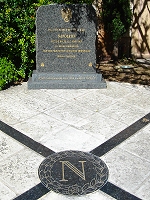
La Route Napoléon.

J gets some last minute advice
from the nez.
|
|
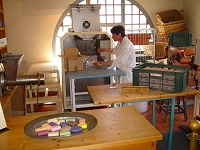
Scented soap manufacturing.
|
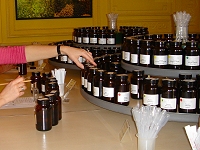
J makes her selections.
|
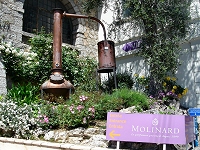
The Molinard factory.
|
|
|
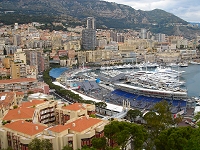
Preparations for the Grand Prix.
|

Fontvieille.
|
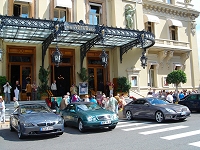
Valet parking at the casino.
|
|
|
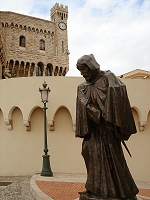
The sneaky François Grimaldi.

The immaculate streets of Monaco's
old town.
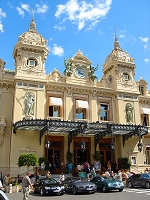
Casino de Monte Carlo.
|
It was time to see where the
beautiful people live. Just at our doorstep (the 271st
doorstep to be exact), we caught the bus for the five
minute ride to the Principality of Monaco. Known for
gambling, banking, and affluence, Monaco is the most
densely populated nation in the world with about 32,000
residents living in less than a square mile. City
planning is understandably a challenge, and the Monégasques
have had to be imaginative in managing their land.
The densely-packed high-rise apartments, the land
reclamation of Fontvieille, and the sprawling underground
train station are all notable examples. Despite the
congestion (although many so-called residents only
claim Monaco home for tax purposes), Monaco is one
of the cleanest and safest places you will ever visit.
But Monaco’s history is more
than just casinos and yachts. According to legend,
a group of friars appealed for refuge at the fortress
atop the Rock of Monaco in the 13th century. Once
inside they massacred the soldiers and claimed the
town as their own. The charlatans were led by the
aptly-named François the Spiteful, a member
of the Grimaldi family who had been expelled from
Genoa. Though a French protectorate, Monaco has been
under Grimaldi rule since that fateful day. So we
began our tour on the very site of the Grimaldi insurrection
with a visit to the Prince’s palace to witness the
changing of the guards. Once the crowd dispersed,
we strolled around the immaculate streets of the old
town and paid homage to the former Prince and Princess
of Monaco at the cathedral. We dined on fine Italian
cuisine and gazed over the city walls at the preparations
being made in Monte Carlo for the following week’s
Grand Prix. The most renowned street circuit race
was first run in 1929 when the Automobile Club de
Monaco needed to organize a race contained entirely
within its borders in order to gain official international
recognition. This year’s race was to be the 64th running.
In Monte Carlo, it is an easy
thing to live above one’s station, if only for a day.
Surrounded by luxury and opulence, we lingered over
a sickeningly expensive coffee at the Café
de Paris. We wandered through the ornate lobby of
the Belle Époque Hotel de Paris. We posed next
to (but not too close to) sleek Jaguars, Rolls Royces,
and Bentleys. We rubbed elbows with high-rolling baccarat
players at the famed Casino de Monte Carlo. We browsed
the boutique windows of Louis Vuitton, Cartier, and
Hermès along the Cercle d’Or (Golden Circle).
Our night of extravagance came to an abrupt end as
we took the bus back to Cap d’Ail.
.
|
|

Changing of the guard.
|

Guarding the palace.
|
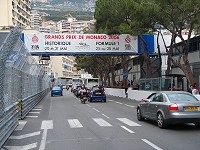
On the circuit.
|
|
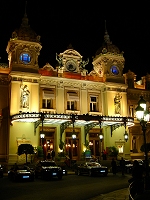
The casino by night.
|
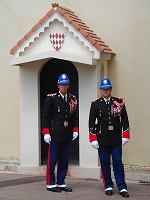
Hey! You with the camera!
|
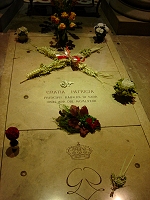
Grace Kelly's tomb.
|
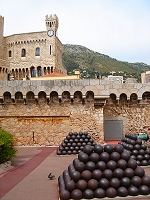
The royal palace.
|
|
|
|
We were due to fly out early
Sunday morning, so we moved our gear to a hotel near
the airport. This gave us a day to find something
to do around Nice. Across the Baie des Anges sits
the town of Antibes. Originally a Greek outpost called
Antipolis or “the city opposite” because of its location
in relation to Nice, Antibes is a charming fortified
town that seems to attract a lot of British tourists.
Antibes has not one but two forts, a city wall, a
market square, a beach, and lots of shops and restaurants,
but the main attraction is the Picasso museum which
displays some of his work from the six month period
in which he lived in the town. However, we will always
remember our brief visit for both crime and punishment.
As we were having lunch, J thought she saw a man slip
a silk scarf into his cargo shorts while browsing
at one of the shops across the street. She alerted
our waiter who unsuccessfully gave chase. We spent
the afternoon walking around town and lamenting the
fact that the Picasso museum was closed for repairs,
when we again spotted the would-be thief browsing
at a shop. This time J tipped off the shopkeeper,
and within a few minutes, two burly gendarmes
had subdued the perpetrator by gently applying a knee
to the back of his head. We fled for fear of having
to answer questions downtown, but last we saw, our
man was being hustled from the scene.
|
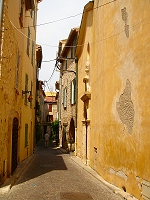
Ochre-facaded buildings line
the old town in Antibes.
|
|
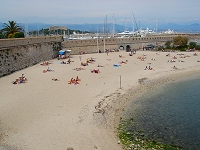
Je vais à la plage.
|

Fort Carré protects the harbor.
|
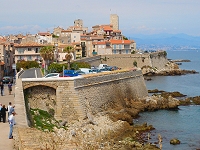
The ramparts.
|
|
Copyright © 2005 JnDsTravelog.com. All rights reserved. |
| |